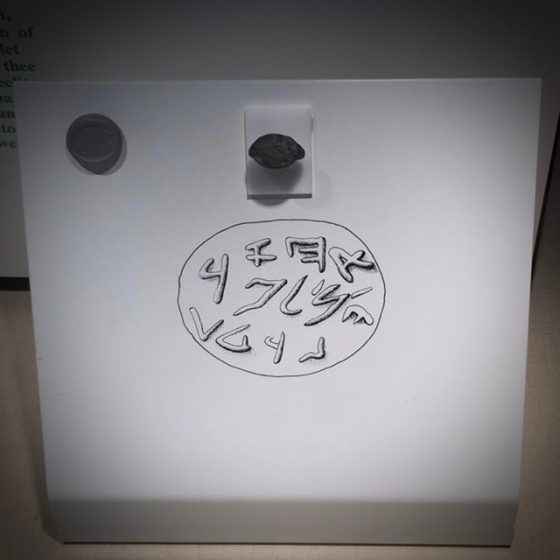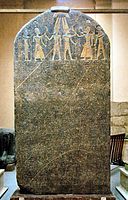Very rarely do we find direct references to characters who appear in the bible in extra biblical material. However, some very prominent characters do have a reference in the inscriptions of the Assyrian and Babylonian kingdoms. These references are usually in relation to war or taxes. The Assyrians specifically mention one great king of Israel, Ahab, son of Omri, who belonged to one of the longer reigning families (however, very short in comparison) of the North.
The Epigraphic Evidence: Monolith of Kurukh
The monolith of Kurukh is an important historical document from Shalmaneser the third (battle of Karkar 853 BC). It recounts his battle against the alliance of the Levant against him. One of the Kings mentioned is king Achav of Israel with 2000 chariots and 10,000 foot soldiers. These numbers are the largest army in the list. Scholars have debated throughout the years the accuracy of such numbers and have suggested that we are looking at a mistake made by one of the scribes. This is a usual practice in this field, to attempt to reduce numbers and present the Northern and Southern kingdoms as smaller. However, one must wonder why these mistakes are by most attributed to information regarding Israel. Admittedly, such corrections have been suggested for other inscriptions. However, it has been a persistent, ongoing practice to target information that has to do with the ancient Israelites.
Kings of Israel were very important at the time, and had a well-established footing in the world (Melmet.A Battles of Israel and Assyria, in “History of Israel in Biblical Times” 1964). This proves the kingship, and the presence of Israel as an organized nation, is much older and does date to the 1400’s BC. This is even reinforced by the very famous Merneptah Stele, 1208 BCE, where Israel is already presented as an actual nation.
Karkar, his royal city, I destroyed, I devastated, I burned with fire. 1,200 chariots, I,200 cavalry, 20,000 soldiers, of Hadad-ezer, of Aram (? Damascus); 700 chariots, 700 cavalry, 10,000* soldiers of Irhulêni of Hamath, 2,000 chariots, 10,000 soldiers of Ahab, the Israelite, 500 soldiers of the Gueans, 1,000 soldiers of the Musreans, 10 chariots, 10,000 soldiers of the Irkanateans, 200 soldiers of Matinuba’il, the Arvadite, 200 soldiers of the Usanateans, 30 chariots, [ ],000 soldiers of Adunu-ba’il, the Shianean, 1,000 camels of Gindibu’, the Arabian, [ ],000 soldiers [of] Ba’sa, son of Ruhubi, the Ammonite, – these twelve kings he brought to his support; to offer battle and fight, they came against me. (Trusting) in the exalted might which Assur, the lord, had given (me), in the mighty weapons, which Nergal, who goes before me, had presented (to me), I battled with them. From Karkar, as far as the city of Gilzau, I routed them. 14,000 of their warriors I slew with the sword. Like Adad, I rained destruction upon them. I scattered their corpses far and wide, (and) covered (lit.., filled) the face of the desolate plain with their widespreading armies. With (my) weapons I made their blood to flow down the valleys(?) of the land. The plain was too small to let their bodies fall, the wide countryside was used up in burying them. With their bodies I spanned the Arantu (Orotes) as with a bridge(?). In that battle I took from them their chariots, their cavalry, their horses, broken to the yoke. (*Possibly 20,000)
Biblical Dating
There are several questions about the above inscription which are important for dating an historical reconstruction of biblical times. But the main point is that Ahab is mentioned here as a leader of a large army in the 9th Century. This dating has vexed several scholars who have tried to date the Northern Kingdom beginning only in the 9th century, but ignore monolithic and royal buildings in the city of Jezreel dating to the 10th century and even earlier. It would require several generations for kingdoms to become that strong. Therefore, the kingdom began earlier, as the bible describes. (Ben-Tor.A “The Argument Over the Historical Truth of the Bible, Yad Ben Tzvi 2001).
We find the same attitude with other inscription such as the Mesha Stele (840 BC) where the “House of Omri” seems to be a very important entity in the area:
“My father reigned over Moab thirty years, and I have reigned after my father. And I have built this sanctuary for Chemosh in Karchah, a sanctuary of salvation, for he saved me from all aggressors, and made me look upon all mine enemies with contempt. Omri was king of Israel, and oppressed Moab during many days, and Chemosh was angry with his aggressions. His son succeeded him, and he also said, I will oppress Moab. In my days he said, Let us go, and I will see my desire upon him and his house, and Israel said, I shall destroy it for ever. Now Omri took the land of Madeba, and occupied it in his day, and in the days of his son, forty years.”
Many historians find a problem with this description due to the timing of it, and conclude that it was actually Ahab and his son Yoram who were kings at the time. This also led scholars to conclude that “Omri” was a royal name, and not a personal name. If true, this shows that Ahab was part of a very strong kingdom that had been around for a long while (Livur Y. in Bustenai.O “History of Israel in the First Temple”, Open U 2007).
How Wicked Was Ahab?
King Ahab of Israel is depicted in the bible as one of the wicked kings of Israel. He marries the daughter of the royal families of Sidon, allows the import of the worship of Ba’al and clashes with the prophet of God, Elijah. He is depicted through the lens of biblical morality. However, between these depictions we also see a man who realizes that he is wrong, and when confronted, seems to somewhat abandon his wicked ways. This can be understood from the fact that he does not react to the slaughter of the prophets of Ba’al, (1King 18), though he is described in 1 Kings 16:29-33 as being instrumental in the import of the worship of Ba’al into the land. It seems to be, from the description in 1 Kings 19, that Izevel (Jezebel) was the true force behind this influence.
In 1 Kings 21:13-22, Ahab battles Hadad, King of the Arameans, and actually respects the word of the prophet of YHWH and acts in accordance to his instructions. However, the entire description of King Ahab and his deeds is a back-and-forth reality of a man who on the one hand is wicked, and on the other hand influenced by his wife and is not necessarily interested in being so wicked. Another case where Izevel is involved in a heinous, wicked act is in 1 Kings 21, with the illegal confiscation of the vineyard of Neboth. This same chapter openly admits that it was Izevel who specifically corrupted him.
רַק, לֹא-הָיָה כְאַחְאָב, אֲשֶׁר הִתְמַכֵּר, לַעֲשׂוֹת הָרַע בְּעֵינֵי יְהוָה–אֲשֶׁר-הֵסַתָּה אֹתוֹ, אִיזֶבֶל אִשְׁתּוֹ
Truly, there was never anyone like Ach’av. Stirred up by his wife Izevel, he gave himself over to do what is evil from Adonai’s perspective. (1 Kings 21:25)
This raises the question of how wicked he really was, though he was described as being “addicted” to wickedness and doing that which was evil in the eyes of YHWH. What puts a dent in this wicked description, though admittedly justified description, is the somewhat heroic ending of his life. In 1 Kings 22, it seems that Ahab is starting to crack and has come to a realization of his evil deeds. It seems that Ahab has become interested in what God has to say to him, something which is very clear from verse 16.
Though Ahab doesn’t say anything directly, his actions speak volumes. He disguises himself and tries to avoid the turmoil of being recognized as the King of Israel, which would make him a target. This probably indicates that Ahab knew that he was wrong, and was an attempt to avoid God’s judgement, indicating his internal conflict. At the end of the battle, Ahab is shot with an arrow and pulls out. It seems, from verse 35, that though Ahab was wounded he kept standing in his chariot to indicate that the king is still standing–an act that usually indicates that the war can continue. It was a common thing for many centuries that if the king fell, the battle was lost.
There is no way of knowing if Ahab repented. However, God’s judgment came to him. The descriptions regarding Ahab throughout the book of Kings indicate a king who strove for power but was also loyal to his people. To his dying breath, he stood in his chariot out of hope that his army would win the battle. Ahab was also very famous for building structures, as indicated in chapter 22 verse 39, and as found in archaeology. However, Ahab failed to understand that power and wealth and a great army are not enough for a kingdom. Only by the will of God and loyalty to Him can a kingdom continue.
Conclusion
From the gathered information found both in archaeology and the bible, we see a correlation of information of a nationalistic king who invested most of his time and energy in trying to make the kingdom of Israel a strong and fortified kingdom. He invested in army, structures and fortifications, and was involved in coalitions and wars with other dominant nations. The bible ignores all these great abilities and sends a message that a king can develop such greatness and still fall, for only with loyalty and obedience to God can all these things be achieved.
Photo Attrtbutions: Ahab’s Insigia Ring; taken by Yoel Halevi, 2017, at Hecht Museum; Merneptah Stele, By Webscribe (Own work) [CC BY-SA 3.0 (http://creativecommons.org/licenses/by-sa/3.0)], via Wikimedia Commons
Originally Published: 26 January 2016


